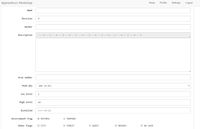Difference between revisions of "Area Header"
| Line 52: | Line 52: | ||
End</pre> | End</pre> | ||
Fields:<BR> | |||
Area Name: This is the name of the zone.<BR> | |||
Installation Date: This is the date of original installation. This date should be populated by the Area Coordinators upon zone install.<BR> | |||
Revision Date: This is system generated and should not be mucked with.<BR> | |||
Author: This is all of the contributing authors for the zone. Separate the names with spaces. Please do not use ampersands or commas.<BR> | |||
Description: This one or two paragraph summary of the zone will be accessible to players, so keep that in mind when crafting this content. You should provide basic information, but not reveal secrets.<BR> | |||
Flags: These are the default settings for the zone, including the type (manmade or natural) and the terrain.<BR> | |||
[[Category:Area Development]] | [[Category:Area Development]] | ||
Revision as of 11:08, 29 April 2016
There are two types of Area headers.
Basic Area Header
The syntax for the header is:
A B C DE F
A: This is the string "#AREA " without the quotes. Following the string, on the same line, is a bunch of text which MUST be laid out precisely in order to keep the area list in neat columns.
B: This is the level range. It starts with a { followed by the low range followed by the high range followed by a }. The field with is 7 positions, and all must be used with { in the first position and } in the 7th.
C: This is the author's name. It starts with a space in position 8, followed by up to 8 characters for the name. Unused character places should be padded with spaces. Position 17 must be a space.
D: This is the name of the area. It starts in position 18. You are allowed up to 20 characters for the name, but you do not have to pad the unused positions with spaces.
E: This is the tilda (the squiggly hyphen).
F: This is the area wide flag denoting the kind of area it is. It is a letter "F" followed by a space followed by a value. The value is chosen from the appropriate part of the flag list, and these values may be combined.
This an example of a classic area header:
#AREA { 1 2} Author Area_Name~ F 1
If this block is used, it is IMPERATIVE it is the FIRST line of the file.
Area Header Two
In 2014, Tynian created a new format for Area Headers. It allows for the listing of multiple contributing authors as well as general information about the zone, which can be accessed using the AREA command. (E.G: AREA AERIE VOLANT) It is the preferred area header style, but the information for the classic header is retained here for historical purposes. It is also available as the default area header when creating zones in the Apprentice's Workshop area writing tool.
It should be noted that the Updated date field is system generated, however the installation date is not. That date should be populated by the Area Coordinators upon zone install.
When formatted, the header looks like this:
#AREA Format 2 Name Aerie Volant~ Installed 2014-03-22 Revision $Revision: 1.11 $ Updated $Date: 2014/07/01 03:21:50 $ Author Cordir Pitt Kerriariadne~ Description The Aerie Volant is an Aara racial home town for the Outland Frontier, carved out of a white stone cliff that overlooks the Maelmordian Sea. It is open to all levels, but be warned - the guards are protective and those of other races may find there is no welcome for them here. Young aarakocrans living in the Aerie can frolic in the pool at the base of the cliff or soar high above the cliffs in the strong breezes. The abundant food found in the Sava River is not far away. ~ Flags City End End
Fields:
Area Name: This is the name of the zone.
Installation Date: This is the date of original installation. This date should be populated by the Area Coordinators upon zone install.
Revision Date: This is system generated and should not be mucked with.
Author: This is all of the contributing authors for the zone. Separate the names with spaces. Please do not use ampersands or commas.
Description: This one or two paragraph summary of the zone will be accessible to players, so keep that in mind when crafting this content. You should provide basic information, but not reveal secrets.
Flags: These are the default settings for the zone, including the type (manmade or natural) and the terrain.
